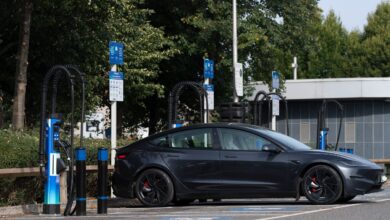The future of wireless retail technology

Register to get 1 free article
Reveal the article below by registering for our email newsletter.
Want unlimited access? View Plans
Already have an account? Sign in
Digital transformation, although a term thrown around a lot within all industries, refers to changes made to business models in order to keep up with changing consumer behaviours.
This comes as a reaction to digital developments across the board that means businesses can streamline processes, to provide a more effective, better than ever experience for the customer. In retail this change is key; however the challenge retailers face is keeping up with the rapid change, and not getting left behind.
Retail saw the most challenging Christmas period in 10 years in 2018, which made for a dampened start to 2019. With this in mind, retailers in the midst of making business changes to keep up with digital transformation need to be wary. Understanding the true implications of digital technology in retail, and where it is best suited is key, ensuring it suits the changes in customer shopping behaviours. All too often, retailers attempt digital transformation without fully understanding how and why the changes are being put in place, which can hinder the business growth and sometimes grind it to a halt.
The integrated approach
Retailers need to get under the skin of their target audience and be in a position to provide them with a seamless shopping experience in store and online to attract purchasing customers and ensure brand engagement to build consumer loyalty. With increasingly more emphasis being placed on driving online sales, brands risk missing out on effective technology solutions that cater to what customers need when in store and the opportunity to support footfall and increase dwell time in the process.
Offering current conveniences such as high-speed Wi-Fi and quick, easy payment methods in well designed stores has successfully improved customer experience for many high street brands. In recent years there is no denying that the readily available proliferation of Wi-Fi offers a bigger picture competitive edge, providing connectivity for the consumer and insight for the brand in a mutually beneficial and high demand service.
The connection expectation
This is because Wi-Fi is an expectation rather than an added value in consumers’ eyes. However, there is an emerging and fresh resource that will provide the same competitive edge for footfall that Wi-Fi once offered and that is wireless charging. As 5G connection becomes more widely available on mobile devices customers are likely to use their mobile for access to internet with fewer using the slower connection of in-store Wi-Fi. Without the attraction of free Wi-Fi, retailers need to find other ways to increase footfall. Providing access to power via smart wireless charging will not only satisfy the consumer’s simple need to stay charged, but it will also increase footfall and dwell time, whilst also providing another data capture point for retailers.
In the future, wireless charging for mobile devices will be crucial for all businesses. This is because more and more retailers will be offering an avenue to meet consumers charging needs and a failure to do so will seem as archaic and unacceptable as a failure to provide a receipt; with the right tools – such as charging spots and advice on how to place them in a manner bespoke to each location’s structure – it will be simple for businesses to execute wireless elements quickly.
Wireless charging is allowing businesses to create a superior customer experience in store. Beyond this, it can also help businesses to create and use rich data to get to know their customers more intimately on a case-by-case, as well as a collective basis. This means that for smaller retailers, there is a real opportunity to move nimbly, beating bigger competitors to implement powerful and attractive technology to keep customers happy, loyal and engaged.
Practically speaking, wireless charging is achieved by embedding wireless power transmitters within or beneath table top surfaces or inside furniture. The transmitter beneath the table is connected to the establishment’s mains power. If a user places a wireless-charging-enabled device above the transmitter (such as the latest iPhones), it will draw power from the transmitter and recharge.
Retailers understand the importance of delivering on a brand promise. Customers have an expectation, and their judgement on a brand is how well the experience with the brand is delivered. So, to be sure to be providing the best and most reliable experience for wireless charging, is to provide “Smart” wireless charging spots, we call them SmartSpots.
This means each individual SmartSpot can be monitored and managed in the cloud and any issues fixed over the air, giving retailers the peace of mind that they are delivering a reliable and seamless service when it comes to keeping their customer powered up. Delivering on a brand promise will help protect a retailer’s social proof – as customer experience and reputation is more important now than ever before, given how visible reviews are in today’s digital world.
Contextual engagement and insight
Retailers integrating smart wireless power in their stores will gain access to hyper-local location data based on where and when the user is charging. This is the key to understanding a customer’s real-life behaviours and movements – brands can analyse customer behaviour from one particular location and contextually engage with users while they charge, and provides the physical touch point which enables digital measurement of the customer experience.
By Dan Bladen, CEO and co-founder of Chargifi, which builds foundational technology that transforms the way the world mass-deploys, manages and monetises power







